Zooming in on a Martian surprise
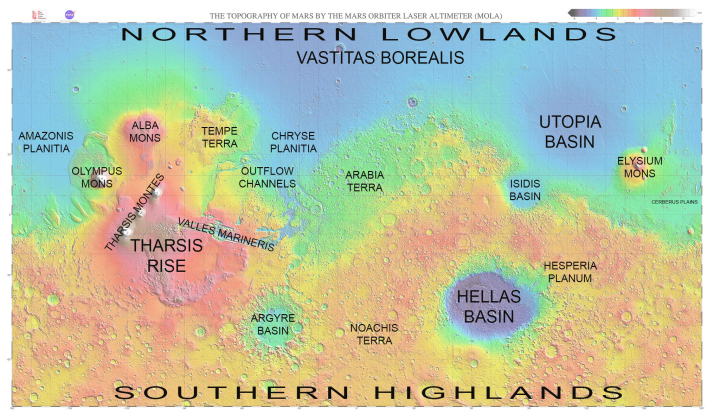
Let’s take a journey. Above is a global map of Mars, showing its largest and well known geological features. While far smaller than Earth, its lack of oceans means that Mars’ actual dry surface has about the same square footage as the continents of Earth. It is a vast place. Getting a close look at every spot is going to take many decades of work, and probably won’t be finished until humans are actually walking its surface.
Let’s pick a spot, zoom in and find out what’s there.
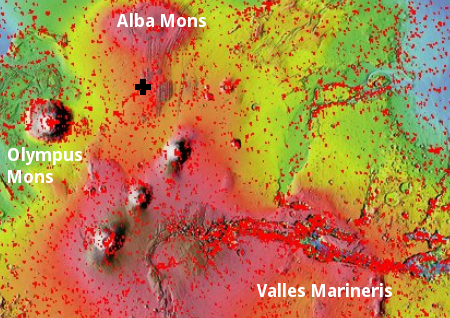
In this case let’s pick a spot to the west of Olympus Mons, the solar system’s largest volcano, and between Tharsis Montes, the string of only slightly smaller giant volcanoes to the east, and Alba Mons, a less distinct giant volcano to the north. The overview map to the right has zoomed in to those volcanoes, with a black cross indicating our target location.
South of Alba Mons and just to the north and east of our target there appear to be a series of parallel troughs, all of which seem related to the Alba Mons volcano. Let’s zoom in some more to see what those are.
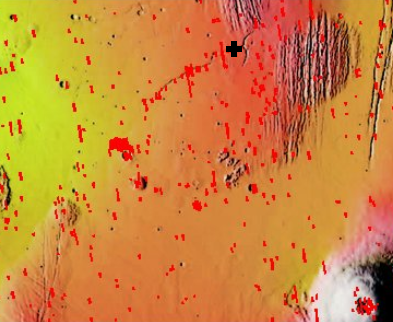
Apparently, when the volcanoes pushed upward here, they either caused a series of north-south cracks to form in the surface crust, or the volcanoes occurred here because there already were these north-south faults. The line of three craters east of Olympus Mons are all formed along a gigantic north-south fault-line that could easily extend northward to this vast field of troughs.
Our target today is not in this fissure field, however. If you want to get a close look you can go to the HiRise archive and zoom in yourself. The red squares on the overview maps indicate the places that the high resolution camera on Mars Reconnaissance Orbiter (MRO) has taken an image. As you can see, only a tiny percentage of the Martian surface has so far gotten a close look. Only a handful of close images have yet been taken of these parallel canyons.
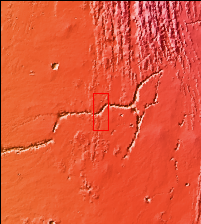
Let’s zoom in some more. The context image on the right shows our real target, Olympica Fossae, a rill-like flow channel to the south and west of the parallel troughs, but mostly running east-west rather than north-south. As described at the website of the image taken of this rill by Mars Odyssey,
Olympica Fossae is a complex channel located on the volcanic plains between Alba Mons and Olympus Mons. The sinuosity of the large channel in the middle of the image indicates that this is a channel created by liquid flow.
The red box in the context image shows the location of the full resolution Mars Odyssey image. The image to the right, reduced and cropped to post here, shows this image. If you click on it you can see the full resolution version. We can now see features on the lava plains to the north and south of this rill, as well as some details on its cliff walls. As noted at the image site,
In this case the location and other surface features point to lava rather than water as the liquid [that caused the flow]. The more linear depressions at the bottom third of the image are possibly tectonic features called graben and formed by movement along fault lines. The Alba Mons region contains extensive faulting which formed due to collapse of the volcano.
As I noted above, it is this faulting that created the parallel troughs. Further evidence that Olympica Fossae was formed by a lava flow can be seen by the line of depressions near the top of the image. These appear similar to collapses you would see into an underground lava tube. Unlike Olympica Fossae, this tube is only been partly revealed to the surface by these sinks, none of which appear to open directly into the underground void that created them. From my cave explorer’s perspective, these depressions would be a great place to dig, as you would have an excellent chance of breaking into a large lava tube cave system with plenty of space to build a habitable base.
The white box indicates where MRO took its own close-up image of Olympica Fossae. The image to the right, cropped and reduced in resolution to post here, shows that area. (The full resolution version can be seen by clicking on the image.)
We can now see details on the rill’s cliff wall. The bottom two-thirds are mostly covered by material that has, over eons, broken off from the cliff and rolled downward to form the long slope down to the floor of the rill. Individual boulders can be discerned faintly, as well as outcrops of underlying bedrock in the slope that has not eroded away as fast. At the top there appear to be four obvious layers, suggesting that the lava flows here occurred at least four times. An even closer image, not yet existing, might reveal even more layers within layers. Understanding how the lava tubes formed within this history however remains a mystery.
The surprises that exist on the Martian surface however are not always obvious. The reason scientists used MRO to take this high resolution image was not simply to study the geology of Olympica Fossae. If you look at the image closely, you will see a dark spot near the top-center, out in the almost featureless plain above the rill. This dark spot is not a dirty smear on your monitor. It is actually a recent small asteroid impact, and the scientists took the image as part of their monitoring campaign to see how that impact site is changing over time. You need to zoom in on the high resolution version to see any details, but even here the resolution is not good enough to pick out many. The dark material is the impact ejecta, spread out on all sides like a splash mark.
There are certainly other mysteries hidden in these images. We just are too far away to see them. We need to get close. We need to be able to get down on our hands and knees and dig. There is a world here to explore.
It sure will be fun for future generations to do it.
On Christmas Eve 1968 three Americans became the first humans to visit another world. What they did to celebrate was unexpected and profound, and will be remembered throughout all human history. Genesis: the Story of Apollo 8, Robert Zimmerman's classic history of humanity's first journey to another world, tells that story, and it is now available as both an ebook and an audiobook, both with a foreword by Valerie Anders and a new introduction by Robert Zimmerman.
The print edition can be purchased at Amazon or from any other book seller. If you want an autographed copy the price is $60 for the hardback and $45 for the paperback, plus $8 shipping for each. Go here for purchasing details. The ebook is available everywhere for $5.99 (before discount) at amazon, or direct from my ebook publisher, ebookit. If you buy it from ebookit you don't support the big tech companies and the author gets a bigger cut much sooner.
The audiobook is also available at all these vendors, and is also free with a 30-day trial membership to Audible.
"Not simply about one mission, [Genesis] is also the history of America's quest for the moon... Zimmerman has done a masterful job of tying disparate events together into a solid account of one of America's greatest human triumphs."--San Antonio Express-News

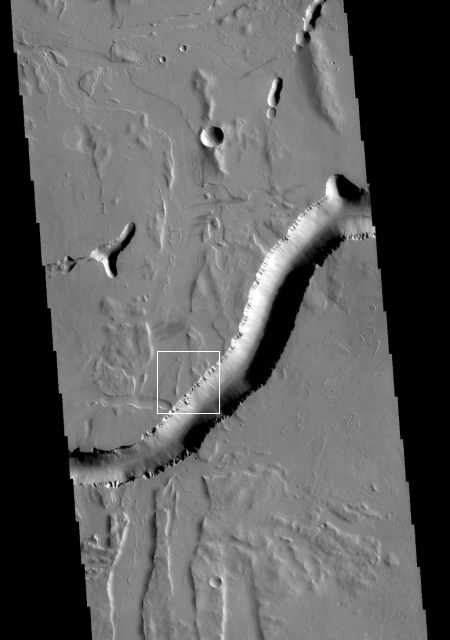
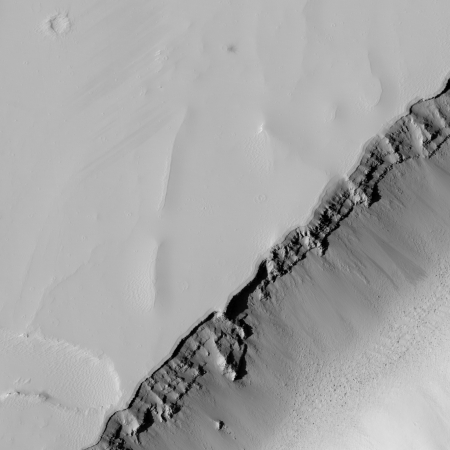

As a product of the 50’s , when I step back , I really wonder if humans can set up shop on a place like Mars for good. More and more, I have serious doubts about it, top of the list is the idea that people will ever get used to living in a space suit.. living on Mars will make living on Antarctica look like living in Hawaii. With todays’ current tech , I just don’t see colonizing Mars as any possibility with in a century. Hope I’m wrong about that.
“It sure will be fun for future generations to do it.”
I’m reminded of the movie “The Martian” when Matt Damon is driving across Mars and remarks that everywhere he goes, every hill he climbs, is a first for a human. It’s a line with profound implications. And we *know* we can grow potatoes.
The largest obstacles to living on Mars appear to be radiation and dust. Of the two, dust will likely be the tougher problem.
Orion314 opined: “[Will people] ever get used to living in a space suit[?] With todays’ current tech , I just don’t see colonizing Mars as any possibility with in a century.”
I think that the first astronauts to Mars will help answer such questions.
Beautiful story, Bob. Thanks.
Perhaps the collapsed tube could be cleaned up on the sides/bottom and spanned over the top to allow for an area with naturalish light. It could be a good compliment to a submartian habitat.